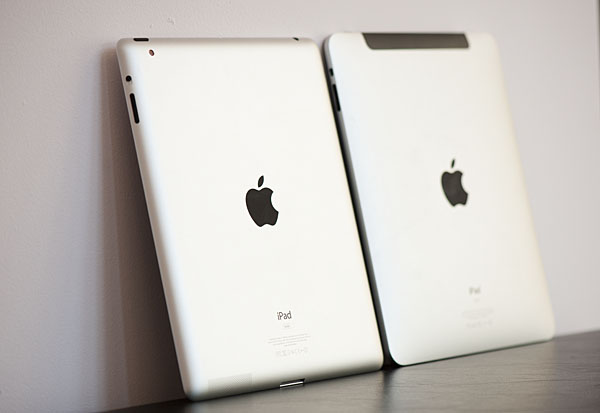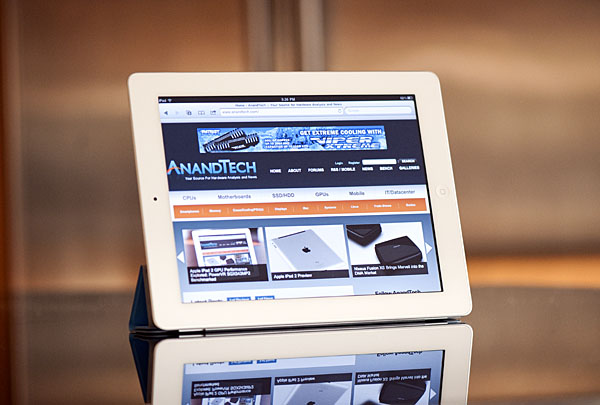The Apple iPad 2 Review
by Brian Klug, Anand Lal Shimpi & Vivek Gowri on March 19, 2011 8:01 PM ESTIndustrial Design & The Future
The original iPad was a device followed by so much hype and anticipation that inevitably, upon launch, it became one of the most polarizing products to launch in the last few years. It also became a huge hit, infusing life into the previously flatlining tablet market, and that's where the iPad 2 comes in.
The industrial design changes are very much in line with what we saw with the 4th generation Apple handhelds. The design language used for the iPhone 3G/3G-S and iPod touch 2G/3G was based on accelerating curvature continuity (known as G3 continuity in industrial design terminology), in contrast to the tangentially continuous design (G1 continuity) found on the original iPhone. What this meant, basically, is that the first iPhone had a relatively flat design, whereas the 3G/3G-S had a gently crowned back that aimed to fit the contour of one's hand.
The original iPad foretold the future of Apple's design language, using a similarly curved back but dumping the blended G3 curvature on the sides for hard edges that met the front face in a perpendicular manner. The iPhone 4 went a step further, with a flat back in addition to the sides. The front profile kept the same rounded corners that every other Apple device has, but the top and side cross-sections end up being rectangles, with all four faces meeting perpendicularly. I'm thinking Apple chose to do this to accomplish two things: being able to use glass for both the front and back faces, as well as to give the iPhone line some separation from the iPod and iPad lines.
The fourth generation iPod touch reaffirmed the notion that Apple was moving back to flatter, more rectangular designs. The use of aluminum instead of glass meant that there wasn't a need for a completely flat back; the predominantly flat back of the iPod tapers to meet the front face at the edges using a short continuous curve.
After seeing the newest iPod touch, I guessed that the second generation iPad would carry rather similar lines. I definitely didn't expect the iPad 2 to be so thin, but overall, it was pretty much in line with what I was expecting.
Another significant aspect to the industrial design changes is the addition of a white-bezeled iPad. The back of both black and white models are the usual anodized aluminum, though the texture of the anodizing on the iPad 2 (as well as the latest MacBook Pros) seems to be a different, smoother one than on previous aluminum Apple devices. Apple seemed to have moved to black bezels on almost all of its products, other than the vaporware-esque white iPhone 4, but between the iPad 2 shipping in white and a promised spring release for the white iPhone 4, it shows that Apple is trending back towards white devices.
The interesting question to ask here is how much we can read into Apple's future designs given the iPad 2, and unfortunately, that isn't a whole lot. It's always difficult to tell with Apple, but it wouldn't surprise me if the iPhone 5 ended up using a very similar design to the iPhone 4. Since the antenna problem is mostly solved (see the antenna diversity on the Verizon iPhone 4), Apple probably doesn't need to do a whole lot to the design for the next generation iPhone. Other than the signal attenuation issues, the iPhone 4 was an amazing piece of hardware, one that Apple spent a lot of money developing. It doesn't make sense for them to turn around and dump it on another ground-up redesign, especially when the 4 is still very competitive from a hardware standpoint. And at this point, I doubt they would focus so much on releasing the white iPhone in spring if they weren't planning on using a very similar chassis for the iPhone 5 that should launch in June.
Given past history, if the iPhone doesn't get a redesign, neither will the iPod touch. Both of the generation 5 handhelds will probably get some form of the A5 SoC, potentially underclocked like the A4 in the iPhone 4. What is more difficult to predict is the 3rd generation iPad. Since we don't really have an established cadence for the iPad, it's hard to say anything about the iPad 3 without reading too much into the iPad 2 launch. I'd say its safe to assume there will be a 6th generation Apple SoC (presumably named the A6), and if I was a betting man, my money would be on at least some form of redesign or at least an ID refresh, but again, with Apple, you really never know.













189 Comments
View All Comments
george1924 - Saturday, March 19, 2011 - link
Seems to be fixed nowAnand Lal Shimpi - Saturday, March 19, 2011 - link
Thanks for the correction :)Take care,
Anand
drugos - Saturday, March 19, 2011 - link
As usual, one of the most comprehensive reviews on the net. Thanks guys!Bosh - Sunday, March 20, 2011 - link
Yes, as usual !PrinceGaz - Saturday, March 19, 2011 - link
Who buys worthless over-priced rubbish like the iPad, apart from hipsters/dickheads? I can understand the appeal of it to them, and I've nothing against dickheads who love them, but what purpose do they serve to the rest of us?!?It's incapable of being used for real work so basically useless except as a toy when out and about, but too large to be carried around in anything smaller than what a small laptop could be carried in, so what it can do when on the move may as well be done on a smartphone.
B3an - Saturday, March 19, 2011 - link
Cant beleive i'm saying this about an Apple product... but the iPad 2 isn't expensive for the hardware. Look at the Motorola Xoom which is lot more expensive for marginally better hardware, although the iPad 2 has better hardware in some areas. The thing is though Apple can sell the iPad 2 at little profit because they just make the money from app sales. So it's hard for other tablet makers to compete on price.I agree with everything else though.
shabby - Saturday, March 19, 2011 - link
The ipad2 is expensive, imagine if asus took their $250 10" netbook and removed the keyboard, replaced the hard drive with a sd card for memory, and ditched the intel mobo/cpu for a slower soc this thing would cost maybe $150.The only reason these devices have these prices is because that's how much people are willing to pay for them.
As for the xoom, motorola for some reason thinks they can charge a premium for it, they certainly are smoking some good shit. These phone manufacturers will fail with their expensive tablets.
Once asus and other netbook manufacturers start saturating the market with android tablets you'll start seeing cheaper solutions.
jalexoid - Saturday, March 19, 2011 - link
That is not true. FOB price for the 16GB XOOM clone(proper quality clone, not a knockoff) is about $330. Smaller components cost more.WaltFrench - Sunday, March 20, 2011 - link
“The only reason these devices have these prices is because that's how much people are willing to pay for them.”Showing off the fact that we've had Econ 101, are we?
Perhaps there's some object/service that operates differently that you'd care to mention.
kukabuka - Saturday, March 19, 2011 - link
Well, I for one think tablets are really great when you don't need a keyboard or a fast processor or a lot of storage. Which would be never. If the iPad sells way better than the Xoom, I'd say your theory about hipsters/dickheads being the only market group for tablets is confirmed.